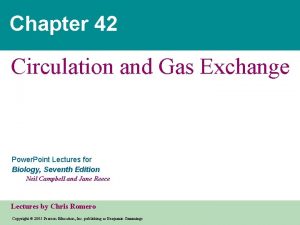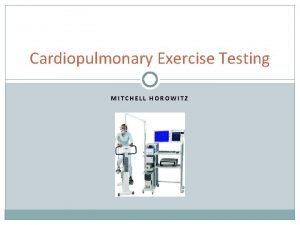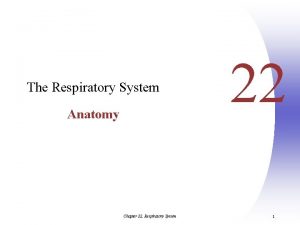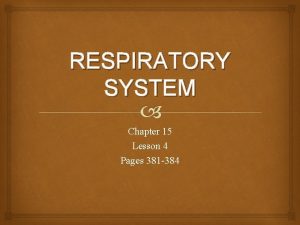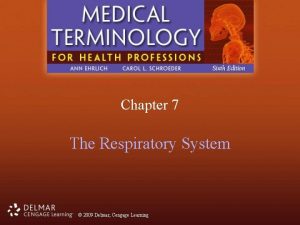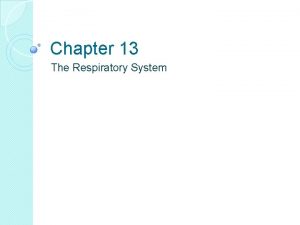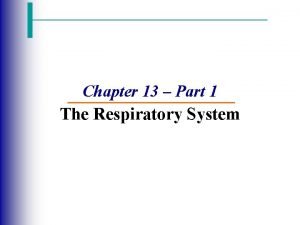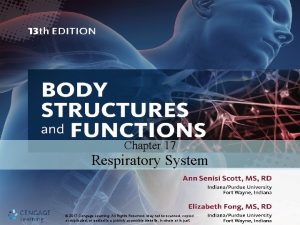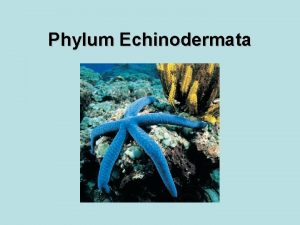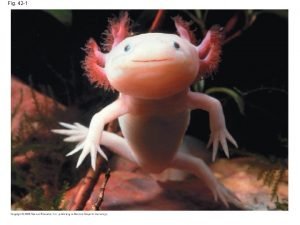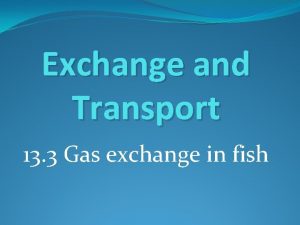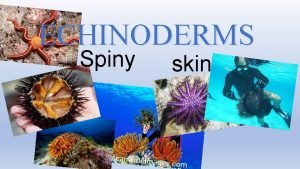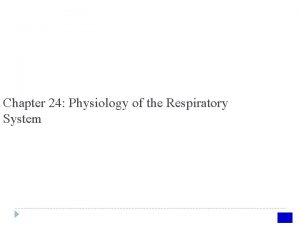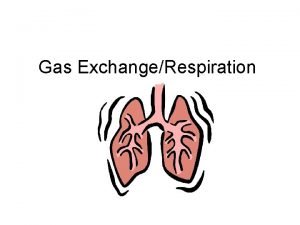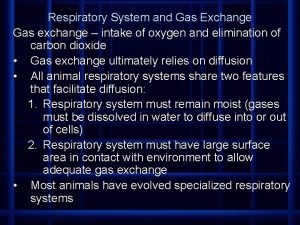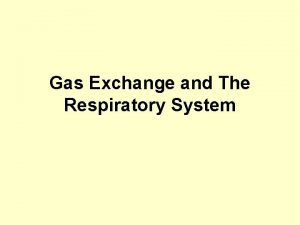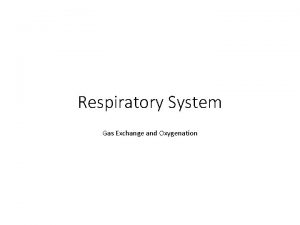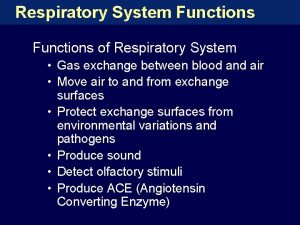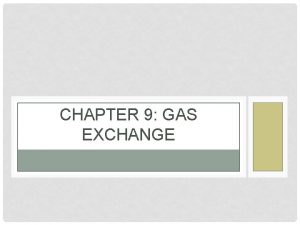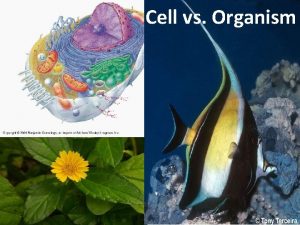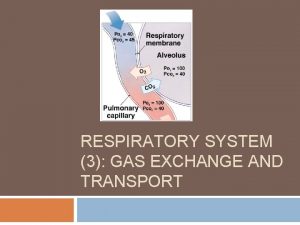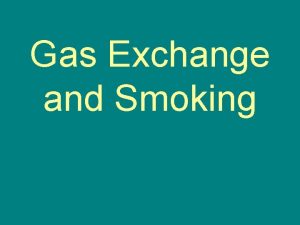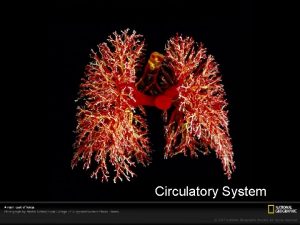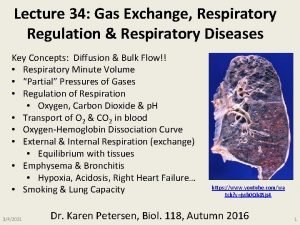Chapter 22 Gas Exchange Respiratory System 22 1
























- Slides: 24

Chapter 22 Gas Exchange / Respiratory System

22. 1 Gas exchange in humans involves breathing, transport of gases, and exchange with body cells Gas exchange, the interchange of O 2 and CO 2 between an organism and its environment, • provides O 2 for cellular respiration and • removes its waste product, CO 2.

22. 2 Animals exchange O 2 and CO 2 across moist body surfaces Respiratory surfaces must be ____ and ____for diffusion of O 2 and CO 2 to occur. • Some animals use their entire skin as a gas exchange organ. • In most animals, gills, a tracheal system, or lungs provide _____________ for diffusion.

22. 3 Gills are adapted for gas exchange in aquatic environments • Gills absorb O 2 dissolved in water. • In a fish, gas exchange is enhanced by ventilation, the flow of water (or air) over the respiratory surface, and countercurrent exchange, the transfer of a substance such as oxygen between two fluids flowing in opposite directions.

22. 4 The tracheal system of insects provides direct exchange between the air and body cells • There are two big advantages to breathing air: 1. Air contains a much higher concentration of O 2 than does water. 2. Air is much lighter and easier to move than water. In what fundamental way does the process of gas exchange in insects differ from that in both fishes and humans? Tracheae • largest channels/openings • connect to the outside

22. 6 In mammals, branching tubes convey air to lungs located in the chest cavity • The diaphragm • separates the abdominal cavity from the thoracic cavity and • helps ventilate the lungs. • In mammals, air is • inhaled through the nostrils into the nasal cavity, • filtered by hairs and mucous surfaces, • warmed and humidified, and • sampled for odors.

22. 6 In mammals, branching tubes convey air to lungs located in the chest cavity • Inhaled air then passes through the pharynx and larynx into the trachea, bronchi, and bronchioles to the alveoli. • Specialized secretions called surfactants prevent the moist surfaces of alveoli from sticking shut. • Mucus and cilia in the respiratory passages protect the lungs. How does the structure of alveoli match their function?

22. 8 Negative pressure breathing ventilates your lungs • Breathing is ventilation of the lungs through alternating inhalation and exhalation. • In humans and other mammals, ventilation occurs by negative pressure breathing, a system in which air is pulled into the lungs. • The contraction of rib muscles and the diaphragm expands the thoracic cavity, reducing air pressure in the alveoli and drawing air into the lungs. Why is inhalation is an active process (requiring work), whereas exhalation is usually passive?

Inhalation Rib cage expands as rib muscles contract Exhalation Air exhaled Rib cage gets smaller as rib muscles relax Air inhaled Lung Diaphragm The diaphragm contracts (moves down) © 2018 Pearson Education, Inc. The diaphragm relaxes (moves up)

22. 9 Breathing is automatically controlled • Breathing control centers in the brain coordinate breathing with body needs by sensing and responding to the p. H of the cerebrospinal fluid, which indicates CO 2 level in the blood. • A drop in blood p. H triggers an increase in the rate and depth of breathing. How is the increased need for O 2 during exercise accommodated by the breathing control centers?

22. 10 Blood transports respiratory gases • The heart pumps oxygen-poor blood to the lungs, where it picks up O 2 and drops off CO 2. • Oxygen-rich blood returns to the heart and is pumped to body cells, where it drops off O 2 and picks up CO 2.

CO 2 in exhaled air Alveolar epithelial cells O 2 in inhaled air Air spaces CO 2 2 O 2 CO O 2 Alveolar capillaries of lung CO 2 -rich, O 2 -poor blood O 2 -rich, CO 2 -poor blood 2 Heart O 2 2 O CO Tissue capillaries CO 2 Interstitial fluid O 2 Tissue cells throughout the body © 2018 Pearson Education, Inc.

Alveoli Gas exchange is driven by diffusion.

Exchange with body cells Gas exchange is driven by diffusion.

Animation: CO 2 from Blood to Lungs © 2018 Pearson Education, Inc.

Animation: CO 2 from Tissues to Blood © 2018 Pearson Education, Inc.

Animation: O 2 from Blood to Tissues © 2018 Pearson Education, Inc.

Animation: O 2 from Lungs to Blood © 2018 Pearson Education, Inc.

22. 11 Hemoglobin carries O 2, helps transport CO 2, and buffers the blood • Most animals transport O 2 bound to proteins called respiratory pigments. • A blue, copper-containing pigment is used by many molluscs and arthropods. • Red, iron-containing hemoglobin • is used by almost all vertebrates and many invertebrates, • transports oxygen and CO 2, and • buffers blood.

22. 12 CONNECTION: The human fetus exchanges gases with the mother’s blood • Fetal hemoglobin attracts O 2 more strongly than does adult hemoglobin. This enhances oxygen transfer from maternal blood in the placenta. • At birth, rising CO 2 in fetal blood stimulates the breathing control center to initiate breathing.

You should now be able to 1. Describe three main phases of gas exchange in a human. 2. Describe four types of respiratory surfaces and the kinds of animals that use them. 3. Explain how the structure of fish gills maximizes oxygen exchange. 4. Describe the tracheal system of insects. 5. Describe the structures and corresponding functions of a mammalian respiratory system.

You should now be able to 6. Explain how breathing is controlled in humans. 7. Explain how blood transports gases between the lungs and tissues of the body. 8. Describe the functions of hemoglobin. 9. Explain how a human fetus obtains oxygen prior to and immediately after birth.

Gas exchange often relies on requires moist, thin (a) (b) for exchange of O 2 to transport gases between red blood cells contain CO 2 (c) needed waste for product of mammals ventilate by and (e) (d) helps to (f) tissue cells regulated by breathing control centers © 2018 Pearson Education, Inc. transport CO 2 and buffer the blood binds and transports (g)

a. b. c. d. e. f. g. h. © 2018 Pearson Education, Inc.
 Gas exchange key events in gas exchange
Gas exchange key events in gas exchange Conducting zone of the respiratory system function
Conducting zone of the respiratory system function Digestive system respiratory system and circulatory system
Digestive system respiratory system and circulatory system The actual exchange of gases occurs at the site of the
The actual exchange of gases occurs at the site of the Chapter 42 circulation and gas exchange
Chapter 42 circulation and gas exchange Wasserman 9 panel plot
Wasserman 9 panel plot How respiratory system work with circulatory system
How respiratory system work with circulatory system Circulatory system and respiratory system work together
Circulatory system and respiratory system work together Chapter 7:10 respitory system
Chapter 7:10 respitory system Chapter 13 the respiratory system
Chapter 13 the respiratory system Respory
Respory Chapter 15 respiratory system
Chapter 15 respiratory system Chapter 7 the respiratory system labeling exercises
Chapter 7 the respiratory system labeling exercises Chapter 34 circulation in humans concept mapping answer key
Chapter 34 circulation in humans concept mapping answer key Chapter 13 the respiratory system
Chapter 13 the respiratory system Figure 13-1 respiratory system
Figure 13-1 respiratory system Chapter 17 respiratory system workbook answers
Chapter 17 respiratory system workbook answers Determination of exchange rate
Determination of exchange rate Voluntary exchange activity the pearl exchange
Voluntary exchange activity the pearl exchange Sea urchin larvae symmetry
Sea urchin larvae symmetry Bioflix activity: gas exchange -- inhaling and exhaling
Bioflix activity: gas exchange -- inhaling and exhaling Gas exchange in fish a level biology aqa
Gas exchange in fish a level biology aqa What is an echinoderm
What is an echinoderm What is the physiology of respiration
What is the physiology of respiration Skin gas exchange
Skin gas exchange




